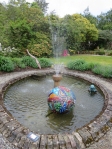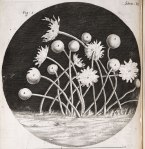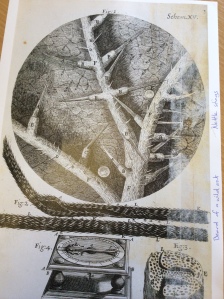We spent last weekend savouring two of the lesser-known delights of the South West moors. We started on Friday on Dartmoor and then moved on to Bodmin Moor that evening.
 Delamore House is on the edge of Dartmoor, and is of special interest to us because it used to be owned by the same family as lived in the house that now contains our apartment. Although it is considerably grander (our house was the family’s ‘summer house’), there were similarities and common features, including a tholos, or cromlech.
Delamore House is on the edge of Dartmoor, and is of special interest to us because it used to be owned by the same family as lived in the house that now contains our apartment. Although it is considerably grander (our house was the family’s ‘summer house’), there were similarities and common features, including a tholos, or cromlech. 
‘Brick chair’ by Amy Cooper
Every year, for the whole of May, Delamore House hosts an art and sculpture exhibition, and we just managed to get there before the end of the month. Both the ground floor of the house, and a stable block across the meadow, were full of paintings; and everywhere we went in the garden we found fascinating sculptures. 
‘Peacock’, by Dot Kuzniar
‘Dancing meadow’ by Nicola Crocker
I really liked this head sculpture, and its companion piece which was a sadder face. Unfortunately I haven’t been able to discover who the sculptor was, so if any of you know, please send me a message.
As one might expect with so many exhibits, they were not all of the same high quality, but in general the standard was good, and some works were excellent.
‘Floating glass sphere’ by Sue Smith

Quite apart from the art, the gardens were exquisite – and this is probably one reason why the month of May is chosen for the exhibition.

The reason for our visit to Bodmin Moor was that I was reading at the Bodmin Moor Poetry Festival. David Woolley and Ann Gray have been running this excellent festival for the last four years, and have created a very special atmosphere with a stunning line-up of poets. On the Friday evening we had a launch party, then settled down for the first reading, which in terms of quality and excitement set the tone for the whole weekend. The two poets this first evening were Sinead Morrissey and David Harsent, the latest two winners of the prestigious T S Eliot prize, and the festival could not possibly have got off to a better start.
 Sinead led a very good workshop the next morning. The event sparkled from start to finish, both because of Sinead’s stimulating input on abstract and concrete writing, and also because the fifteen participants all had intelligent, sensitive and lucid contributions to make.
Sinead led a very good workshop the next morning. The event sparkled from start to finish, both because of Sinead’s stimulating input on abstract and concrete writing, and also because the fifteen participants all had intelligent, sensitive and lucid contributions to make.
My reading came next, shared with two lovely Oversteps poets: Elisabeth Rowe and Mark Totterdell. We were in a conservatory room at this stage, and the sun was beating down; but both we and the audience stayed awake and everyone was ‘warm'(!) and appreciative.
 This was followed by readings by Matthew Francis and Anthony Wilson, which I very much enjoyed. I knew both of these poets a little, but had not heard them read before; so it was a great pleasure. Unfortunately I had to leave after this, as I had another appointment the next morning. I therefore missed a number of other treats. If the programme is anything like as good next year, I recommend that poetry-lovers make the journey to this corner of England, as Bodmin Moor is a festival that is well-worth attending. I shall have to hope that I get another invitation!
This was followed by readings by Matthew Francis and Anthony Wilson, which I very much enjoyed. I knew both of these poets a little, but had not heard them read before; so it was a great pleasure. Unfortunately I had to leave after this, as I had another appointment the next morning. I therefore missed a number of other treats. If the programme is anything like as good next year, I recommend that poetry-lovers make the journey to this corner of England, as Bodmin Moor is a festival that is well-worth attending. I shall have to hope that I get another invitation!
The venue for the festival is the Sterts Theatre at Upton Cross, and the theatre itself is a large amphitheatre covered by a giant awning. As the temperature at night was still a little low  for the time of year, we were relieved to discover that the poetry festival actually takes place in adjacent buildings, complete with walls and roof.
for the time of year, we were relieved to discover that the poetry festival actually takes place in adjacent buildings, complete with walls and roof.
We, of course, spent the night in our camper van, where we were both snug and peaceful. As I included some poems from my latest book (Notes from a Camper Van) in my reading, this was appropriate.
Congratulations to Ann and David on a wonderful festival.
2 Comments






